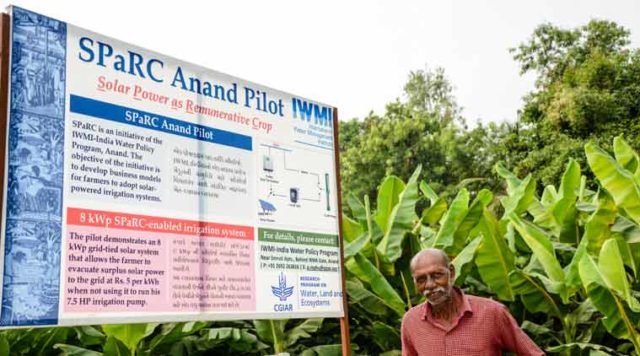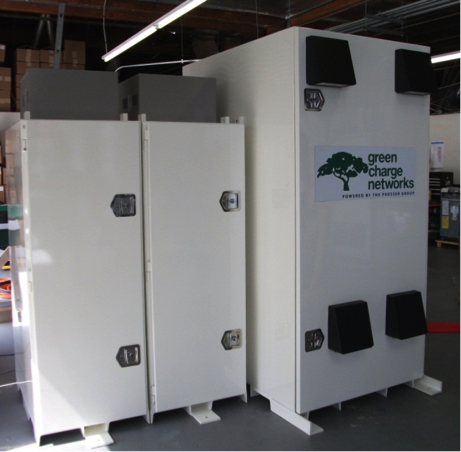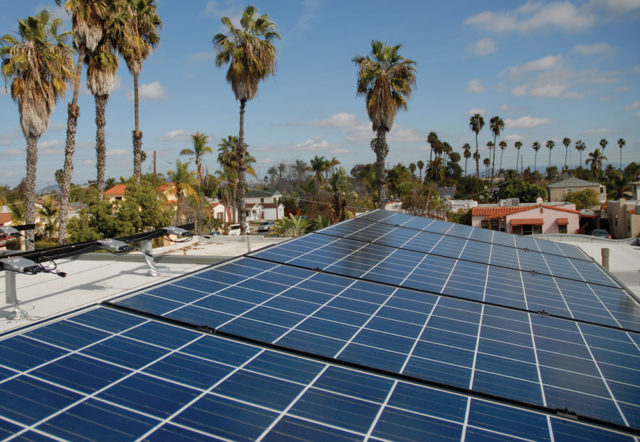Microgrids

– Campus Microgrid for SUNY New Paltz
The New York Power Authority (NYPA) and the State University of New York, New Paltz, have partnered to install a microgrid on the university’s campus. The microgrid will power the university’s Elting Gymnasium, which is also a designated Red Cross emergency shelter.
A 217kW rooftop solar PV array will supply the gymnasium building’s electricity. A hybrid power converter, backup generator and battery energy storage system to be installed in the basement rounds out the microgrid’s components, according to a news report.
Solar Energy
> International

*Indian Express
– First Indian Smallholder Farmers Co-op Brings Solar Energy Array Online
A group of six smallholder farmers in India is helping achieve PM Narendra Modi’s target of doubling farm incomes by 2022. Creating the nation’s first solar cooperative, the six farmers from Dhundi village in the state of Gujarat will soon begin harvesting solar energy, according to a news report.
The solar PV system replaces the diesel-fired power generators the farmers have been using to produce electricity. Each farms less than 1.5 acres of land.
They expect to save on diesel fuel costs by using the electricity to power irrigation pumps, as well as earn about Rs 4,000 a month in supplemental income by dispatching electricity onto the grid.
– Guyana Government Goes Solar
Guyana’s President David Granger announced a four-year plan to install enough solar energy systems to power all government buildings. The plan is part of a broader effort to eliminate the coastal South American country’s addiction to fossil fuels, according to a news report.
“I do believe the private sector will come along with us but my short-term objective is to make the government green and set the model,” he says in response to questions by Demerara Waves Online News.
Energy storage

– French Energy Giant Acquires Green Charge Networks
France’s Engie has acquired a majority stake in Santa Clara-based Green Charge Networks, a young company that has emerged as a leader in the fledgling, fast-growing market for intelligent mid-tier battery energy storage systems, according to a news report.
Engie has bought venture capital group K Road DG’s controlling equity stake in Green Charge. Financial details weren’t disclosed, but K Road DG invested $56 million in Green Charge in the summer of 2014. Green Charge raised $50 million in non-recourse debt financing to expand its business earlier this year.
The company’s lithium-ion battery based energy storage systems have been proving popular with commercial and industrial companies, municipalities and schools looking to reduce high utility peak power demand charges and reduce their carbon emissions footprints. Commercial sector customers include Kaiser Permanente, Safeway, Walgreens and UPS.
>> International
– Total Launches €950 Million Bid for Battery Storage Maker Saft
French oil multinational Total’s bid values Saft at a 38% premium to the value of its outstanding share capital as of market close on Friday, May 6, according to a news report.
Saft’s roots in battery energy storage market go back a long way. It’s considered a market leader today, particularly in the fast-growing market for stationary lithium-ion and other advanced battery technologies. The company employs more than 4,100 people in 19 countries and manufactures nickel and lithium-ion battery systems for use in transportation, civil, commercial, industrial, and military applications.
Total has been more proactive than its peers when it comes to renewable energy. The company owns a 57% equity stake in US-based integrated solar energy company SunPower. Management says it will create a new business group for natural gas, renewable energy, and electricity, according to a news report.
– Australia Green Party Proposes Plan to Spur Residential Battery Storage
Australia’s Green Party proposed a five-year, A$2.9 billion plan to support household and business installations of battery energy storage systems. The support package could be funded by eliminating concessions to fossil fuel-intensive industries, the Greens said.
The support package could result in battery energy storage systems being installed in 1.2 million homes and 30,000 businesses, according to a news report.
Policy & Markets

*Solarprofessional.com
– San Diego Aims for 100% Renewables by 2035
San Diego’s 74-page Climate Action Plan outlines the means by which San Diego could be powered entirely by emissions-free renewable energy by 2035. The city has already established a goal of reducing greenhouse gas emissions 50% by the same year. Other cities, including San Francisco, Sydney, and Vancouver, have also made 100% renewable energy pledges.
– Center for Biological Diversity Identifies 10 Worst States for Solar Energy
The absence of supportive policies and concessions for fossil fuels is hampering growth of emissions-free solar energy in states throughout the US. The Center for Biological Diversity’s Grerr Eyan ranked states according to the degree and extent of supportive policies and then analyzed policy frameworks for the 10 with the greatest solar energy potential but the least amount of installed capacity.
Texas and Florida, for example, ranked second and third, respectively, in terms of solar energy potential, but came in 12th and 14th in terms of installed distributed solar power capacity.
¨In theory, those 10 states could produce up to 35 percent of the nation’s energy supply from rooftop solar installations. Instead, they only account for 6 percent,” states a news report. “If we imagine a world where men and women could install solar panels wherever they provided the most benefits, we would expect the regions with the most potential to have the most installations.”
>> International
– Greenpeace: Brazil Solar Energy Stands to Add 4 Million jobs, $3+ Billion in Taxes
Brazil stands to create as many as 4 million new jobs and take in more than $3 billion in new tax revenue should the government institute measures to foster solar energy growth, according to a Greenpeace report.
Some 8.8 million Brazilian houses and shops could meet their energy needs if solar panels were installed on rooftops, Greenpeace highlights in a press release. Reducing taxes and import duties on solar energy system components and enabling workers to access projects more easily are two measures that the Brazilian government could adopt to help achieve that, Greenpeace says. All measures studied indicated that this goal is achievable based on the responsibility of municipal, regional, and federal governments.
“Public authorities have the power to allow solar energy systems to become more attractive for the population,” says Barbara Rudim, the Greenpeace campaign’s leader. “This study shows the best ways to do this.”
Sustainable Development
– Global Mayors Coalition Launches Sustainable Development Initiative
The mayors of more than 80 major cities around the world launched The Coalition of Urban Transitions in an effort to realize the goals set out in the UN Framework Convention on Climate Change (UNFCCC) agreement signed in Paris this past December.
The New Climate Economy, the C40 Cities Climate Leadership Group, and the WRI Ross Center for Sustainable Cities will work with the coalition to spur growth in projects and policies that address climate change and help realize the UN Sustainable Development Goals, a strategic blueprint that succeeds the UN Millennium Development Goals.
